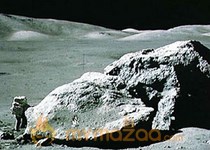A mineral brought back to Earth by the first men on the Moon and long thought to be unique to the lunar surface has been found in Australian rocks more than one billion years old, scientists said Thursday.
Named after Apollo 11's 1969 landing site at the Sea of Tranquility, tranquillityite was one of three minerals first discovered in rocks from the Moon and the only one not to be found, in subsequent years, on Earth.
Australian scientist Birger Rasmussen said tranquillityite had "long been considered as the Moon's own mineral" until geologists discovered it, by chance, in rock from resources-rich Western Australia.
"In over 40 years it hadn't been found in any terrestrial samples," Rasmussen, from Curtin University, told.
When the Moon samples first came back Rasmussen said they were considered to be "extremely precious" and had been subjected to intense, detailed study when -- ironically -- their contents were "right here all the time."
"They were always part of Earth, they haven't come from the Moon," he said of his work on the discovery, published in the journal Geology. "It tells you that broadly overall you have similar chemistries and similar processes operating on the Moon as on Earth."
As well as being "quirky and surprising" Rasmussen said the discovery also had important practical applications, with the mineral proving to be an excellent dating tool which had allowed scientists to pin down the rocks' age.
"We used this mineral ... to date the dolerite which has previously been undated, so that helped us understand the geological history," he said.
They were 1.07 billion years old, more ancient than rocks in the area had previously been thought to be, and Rasmussen said tranquillityite would be useful in dating similar rocks in the future.
"I think it will be a lot more widespread than just the six locations we've found it so far," he added of the rare mineral.







